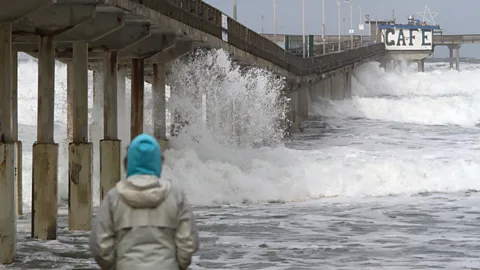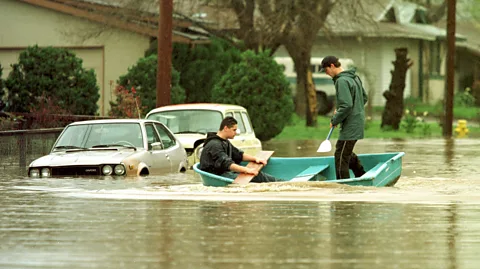The high cost of an El Niño in 2023
 Bill Wechter / Getty Images
Bill Wechter / Getty ImagesScientists have announced the start of a potentially strong El Niño climate pattern in June 2023. What effect might that have on our lives?
A vast body of warm water has been slowly sloshing across the tropical Pacific Ocean in the direction of South America. This movement of water and heat has now triggered the start of a climate phenomenon that will bring dramatic shifts in weather patterns around the world over the coming months.
Climate scientists have just announced that an El Niño weather pattern has taken hold and will strengthen through to the end of this year and the first months of 2024. And they are warning there is a good chance that it could be a particularly strong El Niño this year.
If that turns out to be the case, then the impacts could be significant. Scientists have already warned that with rising emissions and a strong El Niño there is a 66% chance the world will break through a key 1.5C global warming limit at least one year between now and 2027. But it could also bring damaging extreme weather such as heavy rainfall and flooding to communities in the US and elsewhere this winter.
"We expect El Niño to continue into the winter, and the odds of it becoming a strong event at its peak are pretty good, at 56%. Chances of at least a moderate event are about 84%," wrote Emily Becker, associate director of the Univeristy of NMiami's Coperative Institute for Marine and Atmopsheric Studies, on the National Oceanic and Atmospheric Administration's (NOAA) blog.
The effects of this could also reverberate for some time to come – a recent study by researchers at Dartmouth College, Hanover, New Hampshire, estimates that an El Niño starting in 2023 could cost the global economy as much as $3.4tn (£2.7tn) over the following five years. And they say that following two previous very strong El Niño events in 1982-83 and 1997-98, the US gross domestic product was 3% lower half a decade later than it otherwise would have been. If an event of a similar magnitude was to happen today, it could cost the US economy $699bn (£565bn), they calculated.
It is worth noting that coastal tropical countries such as Peru and Indonesia, however, suffered a 10% drop in GDP following the same El Niño events, the researchers say. They project that global economic losses will amount to $84tn (£68tn) this century as climate change increases the frequency and strength of El Niño events.
"El Niño is not simply a shock from which an economy immediately recovers. Our study shows that economic productivity in the wake of El Niño is depressed for a much longer time than simply the year after the event," says Justin Mankin, co-author of the study and assistant professor of geography at Dartmouth College.
"When we talk about an El Niño here in the United States, it means that the types of impacts that we'll see, floods and landslides, aren't typically insured against by most households and businesses," says Mankin. In California, for example, 98% of homeowners don't have flood insurance.
Other economic impacts in the US could include infrastructure damage from flooding, which would lead to supply chain disruption, and poor harvests caused by floods or drought, says Mankin.
You might also like:
But should people in the US be bracing themselves for a particularly miserable winter this year if there is an arrival of El Niño? Not necessarily. While El Niño can bring intense periods of extreme weather to North America, it doesn't always do so.
During El Niño, winds that usually push warmer water in the Pacific Ocean towards its west side weaken, allowing the warmer water to drift back towards the east and spread out over a larger area of the ocean. This leads to more moisture-rich air above the warmer ocean that alters the circulation of air in the atmosphere around the world. In North America, this typically causes Canada and the northern US to have a warmer, drier winter than normal while the southern states and Gulf coast tend to get wetter conditions, says DeWitt.
What are El Niño and La Niña?
El Niño and La Niña are naturally occurring phenomena that disrupt weather patterns worldwide. During El Niño the ocean surface temperatures of the Pacific Ocean are higher than normal. During La Niña, its cooler counterpart, ocean temperatures are lower than normal
"El Niño tends to enhance the probability of above normal precipitation for the southern third of the US," says David DeWitt, director of the US NOAA's Climate Prediction Center. El Niño also typically reduces the number of hurricanes in the Atlantic Ocean, but can lead to more hurricanes to the Pacific coast of the US. But all these effects largely depend on the strength of the El Niño that is driving them.
Southern states in the US are the most likely to experience severe impacts, including heavy rainfall and potential flash flooding, DeWitt warns. This would come after several years of drought following three consecutive La Niña seasons.
"Frequently what happens [during El Niño] is that when the rain comes, it comes very fast. That can cause mudslides in California and in other places where there have been wildfires, which can be quite devastating," says DeWitt. This is because scorched earth is able to retain less water, which can lead to dangerous runoff. The strong El Niño events of 1997-98 and 2015-16, for example, brought flooding and mudslides to California. The 1997-98 event was also associated with other unusual extreme events elsewhere in the country, such as severe ice storms in New England and deadly tornadoes in Florida.
 John Mabanglo / Getty Images
John Mabanglo / Getty ImagesBut the changes in weather patterns brought by El Niño also brings other problems. Infectious diseases can become more prevalent in areas where conditions favour the insects and other pests that spread them. One study of the 2015-2016 El Niño event found that disease outbreaks became between 2.5%-28% more intense. There were increases in cases of West Nile virus, spread by mosquitoes, in California, while New Mexico, Arizona, Colorado, Utah and Texas also saw increase outbreaks of hantavirus pulmonary syndrome, which is mainly spread by rodents. There were even increases in the number of human cases of plague – if still only a handful of cases – in the western and southwestern states of the US.
During El Niño a lot of heat and moisture is transported from the tropics towards the poles. "When you increase the moisture at higher latitudes, it traps more thermal infrared radiation which leads to warming. This is what we call the greenhouse effect," says DeWitt.
Even a temporary breach of the 1.5C threshold due to rising emissions and this year's El Niño, as predicted by the World Meteorological Organization, could lead to widespread human suffering worldwide. According to a recent study by the University of Exeter in the UK, limiting long-term global warming to 1.5C could save billions of people from exposure to dangerous heat (average temperature of 29C or higher).
Current policies are projected to lead to 2.7C of warming globally by the end of the century, which could leave two billion people exposed to dangerous levels of heat worldwide, the authors say. Limiting warming to 1.5C would mean five times fewer people live in dangerous heat and would help prevent climate-related migration and detrimental health outcomes, including pregnancy loss and impaired brain function, says Tim Lenton, co-author of the study and director of the Global Systems Institute at the University of Exeter.
There are concerns that as carbon emissions continue to rise, future El Niño events might tip global temperatures above the 1.5C threshold more and more often.
"Every 0.1C really matters," says Lenton. "Every 0.1C of warming we can avoid, by our calculation, is saving 140 million people from exposure to unprecedented heat and the harms that could come with it."
"It's saving hundreds of millions of people from harm and that should be a huge incentive to work harder to get to zero emissions."
* This article was orginally published on 25 May but has been updated to reflect the announcement that El Niño conditions are now present.
--
